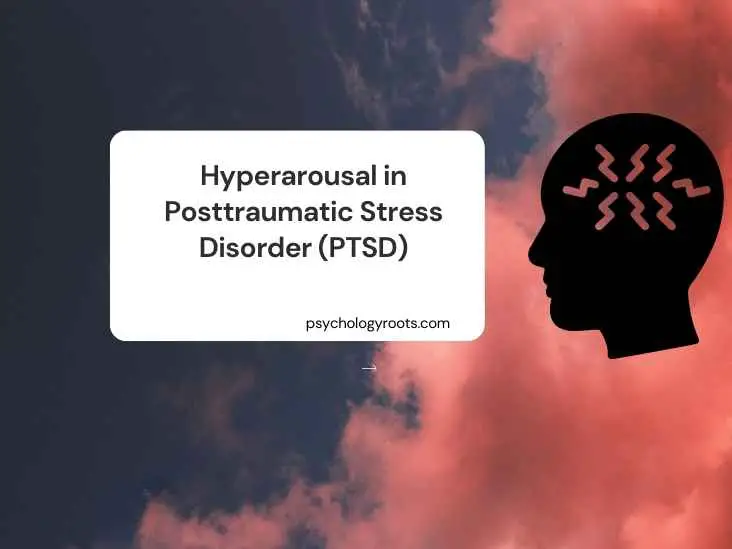Table of Contents
Hyperarousal in Posttraumatic Stress Disorder (PTSD)
Here in this post, we are discussing “Hyperarousal in Posttraumatic Stress Disorder (PTSD)”. You can read more about psychology-related material on our website. Keep visiting Psychology Roots.
Many persons with post-traumatic stress disorder (PTSD) develop hyperarousal, a psychophysiological condition (PTSD). Hyperarousal, as its name indicates, is characterized by an excess of both mental and physical arousal that may disrupt daily living and sleep. Accidents, war, natural catastrophes, and sexual abuse are all examples of traumatic experiences that may lead to PTSD hyperarousal.
Hyperarousal impairs everyday activities because it puts the body and mind on high alert all the time. The fight-or-flight branch of the autonomic nervous system is responsible for maintaining chronically elevated levels of arousal in the body’s tissues.
Causes of Hyperarousal
PTSD symptoms may be triggered by anything that triggers a person’s memory of a traumatic experience. Here are a few scenarios that might raise your blood pressure and heart rate:
- It’s possible that smelling diesel fuel at the same time and location that you had a life-threatening incident — such as an accident — may bring up memories of the traumatic experience.
- A freezing rain indicator in the weather forecast before you leave for your daily commute if you’ve been involved in an accident on black ice.
- An old song that brings back memories of a horrific occurrence is heard in the checkout queue at a supermarket.
Activating events such as these may cause an immediate state of hyperarousal in the brain.
Autonomic hyperarousal is accompanied by the following physiological symptoms:
- Slowing of the heartbeat
- Blood pressure that is too high
- hands were tingling.
- a feeling of breathlessness
- Hyperarousal is a psychologically uncomfortable condition that often causes individuals to feel anxious or panicked. Hyperarousal puts the body and mind on high alert even when there is no genuine threat.
Hyperarousal is common in those who are stressed and unable to unwind. It’s exhausting to remain “on guard” and hypervigilant all of the time. The ripple consequences of hyperarousal have a negative impact on people’s capacity to function on a daily basis.
The autonomic nervous system’s stress response may become dysregulated over time as a result of PTSD-related triggering experiences. When the body’s built-in stress reactions are always on high alert, chronic hyperarousal develops.
Epinephrine (adrenaline) and norepinephrine, two chemical messengers in our brains, activate the body’s fight-or-flight response immediately, which may protect us from danger. However, excessive amounts might contribute to hyperarousal in post-traumatic stress disorder (PTSD).
Symptoms of Hyperarousal
The American Psychiatric Association’s guide to identifying mental health issues, the Diagnostic and Statistical Manual of Mental Disorders (DSM-5), emphasizes six symptom clusters related to hyperarousal.
- Anger or angry outbursts
- Impulsivity
- Hypervigilance
- Excessive startle reflex
- Attention issues
- Sleep disruption and insomnia
Treatment of Hyperarousal
There are many different ways to treat excessive hyperarousal, including psychotherapy, medication, neurotechnology-based treatment, and lifestyle changes such as dietary changes, meditation, or regular physical exercise.
Here are some specific examples:
- Cognitive-behavioral therapy (CBT)
- Diaphragmatic breathing exercises
- Exposure therapy
- Eye movement desensitization and reprocessing (EMDR)
- Medications (e.g., antidepressants or anti-anxiety drugs)
- Mindfulness-based stress reduction
- Progressive muscle relaxation
- Non-invasive vagus nerve stimulation
Key Points
Hyperarousal is a condition induced by hyperactive fight-or-flight stress reactions that keep the body and mind on high alert even when there is no need to be on the defensive. It is a symptom of post-traumatic stress disorder that is often observed.
Being in a permanent state of alertness may have a variety of negative effects on one’s everyday life, including making it difficult to sleep. If left unchecked, this vicious cycle has the potential to spiral out of control. Therapy, medicine, and mind-body exercises are all effective treatments for this condition, which is fortunately widespread.
Help Us Improve This Article
Have you discovered an inaccuracy? We put out great effort to give accurate and scientifically trustworthy information to our readers. Please notify us if you discover any typographical or grammatical errors.
Make a comment. We acknowledge and appreciate your efforts.
If you have any scale or any material related to psychology kindly share it with us at psychologyroots@gmail.com. We help others on behalf of you.
